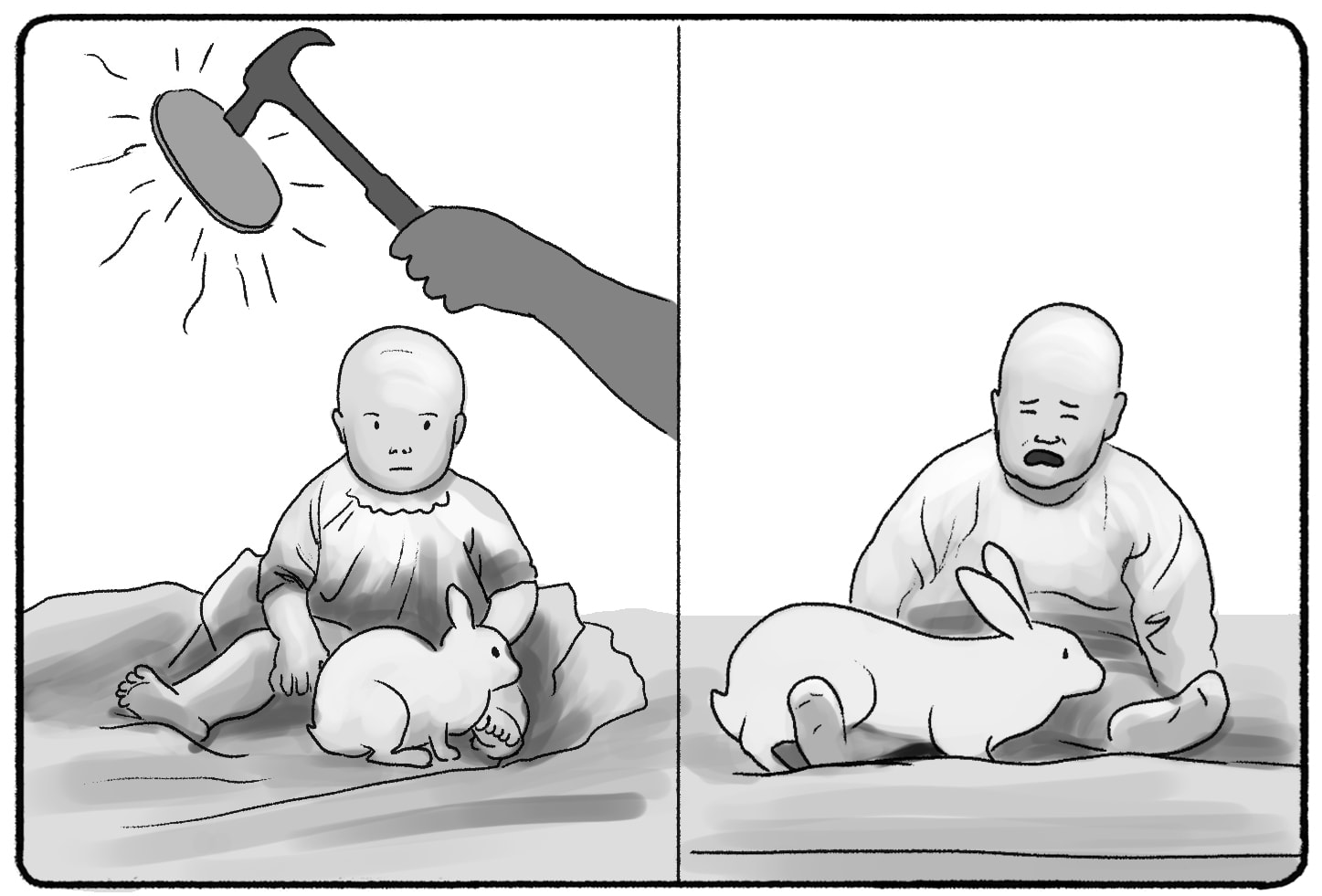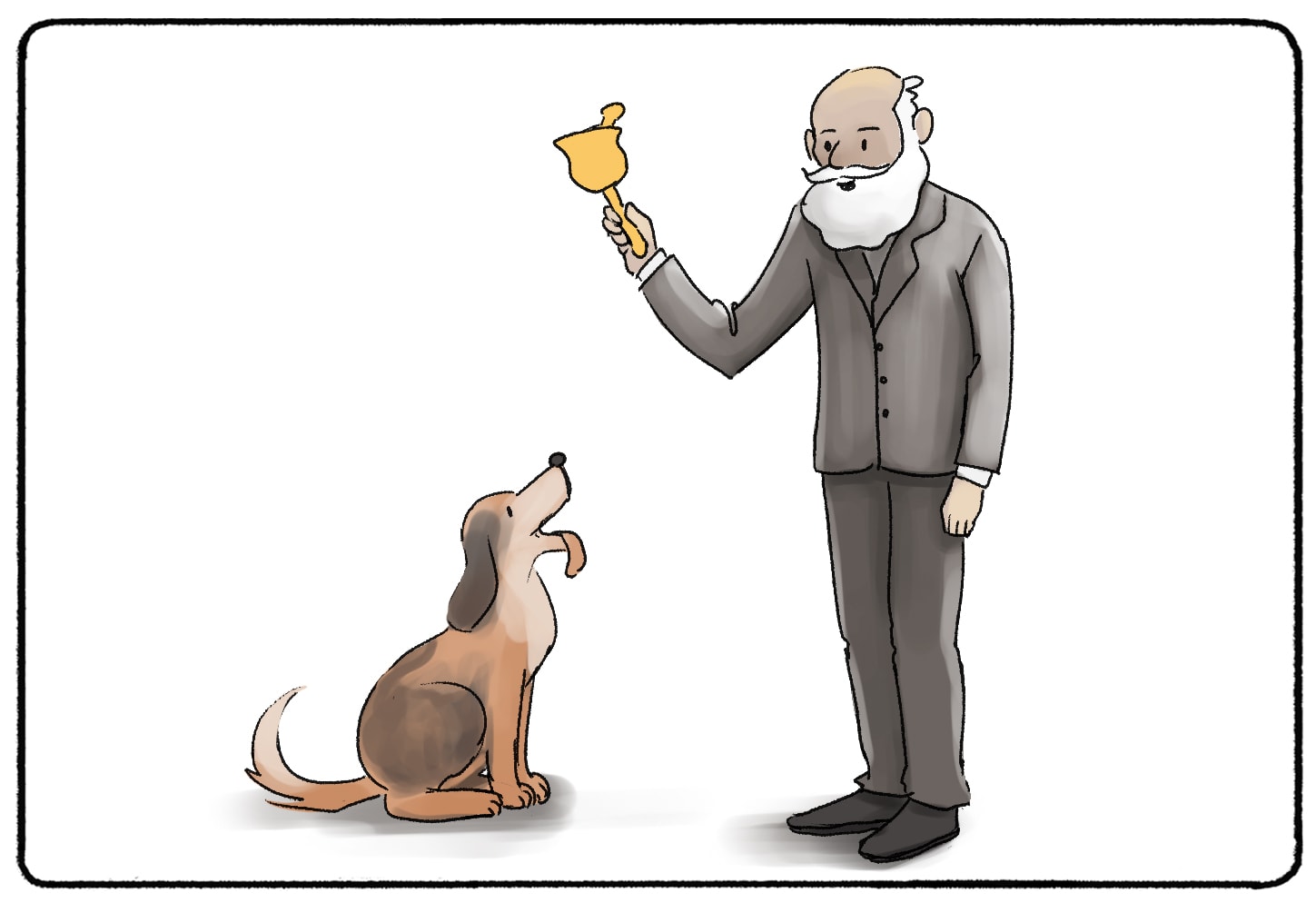The Little Albert Experiment is a world-famous study in the worlds of both behaviorism and general psychology. Its fame doesn’t just come from astounding findings. The story of the Little Albert experiment is mysterious, dramatic, dark, and controversial.
The Little Albert Experiment was a study conducted by John B. Watson and Rosalie Rayner in 1920, where they conditioned a 9-month-old infant named "Albert" to fear a white rat by pairing it with a loud noise. Albert later showed fear responses to the rat and other similar stimuli.
The Little Albert Experiment is one of the most well-known and controversial psychological experiments of the 20th century. In 1920, American psychologist John B. Watson and his graduate student, Rosalie Rayner, carried out a study. Their goal was to explore the concept of classical conditioning. This theory proposes that individuals can learn to link an emotionless stimulus with an emotional reaction through repeated pairings.
For their experiment, Watson and Rayner selected a 9-month-old infant named "Albert" and exposed him to a series of stimuli, including a white rat, a rabbit, a dog, and various masks. Initially, Albert showed no fear of any of these objects. However, when the researchers presented the rat to him and simultaneously struck a steel bar with a hammer behind his head, Albert began to cry and show signs of fear. After several repetitions of this procedure, Albert began to show a fear response to the rat alone, even when the loud noise was not present.
The experiment was controversial because of its unethical nature. Albert could not provide informed consent, and his fear response was deliberately induced and not treated. Additionally, the experiment lacked scientific rigor regarding experimental design, sample size, and ethical considerations. Despite these criticisms, the Little Albert Experiment has had a significant impact on the field of psychology, particularly in the areas of behaviorism and classical conditioning. It has also raised important questions about the ethics of research involving human subjects and the need for informed consent and ethical guidelines in scientific studies.
Let's learn who was behind this experiment...
Who Was John B. Watson?

John B. Watson is pivotal in psychology's annals, marked by acclaim and controversy. Often hailed as the "Father of Behaviorism," his contributions extend beyond the well-known Little Albert study. At Johns Hopkins University, where much of his groundbreaking work was conducted, he delivered the seminal lecture "Psychology as the Behaviorist Views It."
This speech laid the foundation for behaviorism, emphasizing observable and measurable behavior over introspective methods, a paradigm shift in how psychological studies were approached. Watson's insistence on studying only observable behaviors positioned psychology more closely with the natural sciences, reshaping the discipline. Although he achieved significant milestones at Johns Hopkins, Watson's tenure there ended in 1920 under controversial circumstances, a story we'll delve into shortly.
Classical Conditioning
John B. Watson was certainly influential in classical conditioning, but many credit the genesis of this field to another notable psychologist: Ivan Pavlov. Pavlov's groundbreaking work with dogs laid the foundation for understanding classical conditioning, cementing his reputation in the annals of psychological research.
Classical conditioning is the process wherein an organism learns to associate one stimulus with another, leading to a specific response. Pavlov's experiment is a quintessential example of this. Initially, Pavlov observed that dogs would naturally salivate in response to food. During his experiment, he introduced a neutral stimulus, a bell, which did not produce any specific response from the dogs.
However, Pavlov began to ring the bell just before presenting the dogs with food. After several repetitions, the dogs began to associate the sound of the bell with the forthcoming food. Remarkably, even without food, ringing the bell alone led the dogs to salivate in anticipation. This involuntary response was not a behavior the dogs were intentionally trained to perform; instead, it was a reflexive reaction resulting from the association they had formed between the bell and the food.
Pavlov's research was not just about dogs and bells; its significance lies in the broader implications for understanding how associative learning works, influencing various fields from psychology to education and even marketing.
Who Was Little Albert?
John B. Watson took an idea from this theory. What if...
- ...all of our behaviors were the result of classical conditioning?
- ...we salivated only after connecting certain events with getting food?
- ...we only became afraid of touching a stove after we first put our hand on a hot stove and felt pain?
- ...fear was something we learned?
These are the questions that Watson attempted to answer with Little Albert.

Little Albert was a nine-month-old baby. His mother was a nurse at Johns Hopkins University, where the experiment was conducted. The baby’s name wasn’t really Albert - it was just a pseudonym that Watson used for the study. Due to the baby’s young age, Watson thought it would be a good idea to use him to test his hypothesis about developing fear.
Here’s how he conducted his experiment, now known as the “Little Albert Experiment.”
Watson exposed Little Albert to a handful of different stimuli. The stimuli included a white rat, a monkey, a hairy mask, a dog, and a seal-skin coat. When Watson first observed Little Albert, he did not fear any stimuli, including the white rat.
Then, Watson began the conditioning.
He would introduce the white rat back to Albert. Whenever Little Albert touched the rat, Watson would smash a hammer against a steel bar behind Albert’s head. Naturally, this stimulus scared Albert, and he would begin to cry. This was the “bell” of Pavlov’s experiment, but you can already see that this experiment is far more cruel.

Like Pavlov’s dogs, Little Albert became conditioned. Whenever he saw the rat, he would cry and try to move away from the rat. Throughout the study, he exhibited the same behaviors when exposed to “hairy” stimuli. This process is called stimulus generalization.
What Happened to Little Albert?
The Little Albert study was conducted in 1920. Shortly after the findings were published in the Journal of Experimental Psychology, Johns Hopkins gave Watson a 50% raise. However, the rise (and Watson’s position at the University) did not last long. At the end of 1920, Watson was fired.
Why? At first, the University claimed it was due to an affair. Watson conducted the Little Albert experiment with his graduate student, Rosalie Rayner. They fell in love, despite Watson’s marriage to Mary Ickes. Ickes was a member of a prominent family in the area, upon the discovery of the affair, Watson and Rayner’s love letters were published in a newspaper. John Hopkins claimed to fire Watson for “indecency.”
Years later, rumors emerged that Watson wasn’t fired simply for his divorce. Watson and Rayner were allegedly conducting behaviorist experiments concerning sex. Those rumors included claims that Watson, a movie star handsome then, had even hooked devices up to him and Rayner while they engaged in intercourse. These claims seem false, but they appeared in psychology textbooks for years.
There is so much to this story that is wild and unusual! Upon hearing this story, one of the biggest questions people ask is, “What happened to Little Albert?”
The True Story of the Little Albert Experiment
Well, this element of the story isn’t without uncertainty and rumor. In 2012, researchers claimed to uncover the true story of Little Albert. The boy’s real name was apparently Douglas Merritte, who died at the age of seven. Merritt had a serious condition of built-up fluid in the brain. This story element was significant - Watson claimed Little Albert was a healthy and normal child. If Merritte were Little Albert, then Watson’s lies about the child’s health would ruin his legacy.
And it did until questions about Merritte began to arise. Further research puts another candidate into the ring: William Albert Barger. Barger was born on the same day in the same hospital as Merritte. His mother was a wet nurse in the same hospital where Watson worked. Barger’s story is much more hopeful than Merritte’s - he died at 87. Researchers met with his niece, who claimed that her uncle was particularly loving toward dogs but showed no evidence of fear that would have been developed through the famous study.
The mystery lives on.
Criticisms of the Little Albert Experiment
This story is fascinating, but psychologists note it is not the most ethical study.
The claims about Douglas Merritte are just one example of how the study could (and definitely did) cross the lines of ethics. If Little Albert was not the healthy boy that Watson claimed - well, there’s not much to say about the findings. Plus, the experiment was only conducted on one child. Follow-up research about the child and his conditioning never occurred (but this is partially due to the scandalous life of Watson and Rayner.)
Behaviorism, the school of psychology founded partly by this study, is not as “hot” as it was in the 1920s. But no one can deny the power and legacy of the Little Albert study. It is certainly one of the more important studies to know in psychology, both for its scandal and its place in studying learned behaviors.
Other Controversial Studies in Psychology
The Little Albert Experiment is one of the most notorious experiments in the history of psychology, but it's not the only one. Psychologists throughout the past few decades have used many unethical or questionable means to test out (or prove) their hypotheses. If you haven't heard about the following experiments, you can read about them on my page!
The Robbers Cave Experiment
Have you ever read Lord of the Flies? The book details the shocking and deadly story of boys stranded on a desert island. When the boys try to govern themselves, lines are drawn in the sand, and chaos ensues. Would that actually happen in real life?
Muzafer Sherif wanted to find out the answer. He put together the Robbers Cave Experiment, which is now one of the most controversial experiments in psychology history. The experiment involved putting together two teams of young men at a summer camp. Teams were put through trials to see how they would handle conflict within their groups and with "opposing" groups. The experiment's results led to the creation of the Realistic Conflict Theory.
The experiment did not turn out like Lord of the Flies, but the results are no longer valid. Why? Sherif highly manipulated the experiment. Gina Perry's The Lost Boys: Inside Muzafer Sherif's Robbers Cave Experiment details where Sherif went wrong and how the legacy of this experiment doesn't reflect what actually happened.
Read more about the Robber's Cave Experiment.
The Stanford Prison Experiment
The Stanford Prison Experiment looked similar to the Robbers Cave Experiment. Psychologist Phillip Zimbardo brought together groups of young men to see how they would interact with each other. These participants, however, weren't at summer camp. Zimbardo asked his participants to either be a "prison guard" or "prisoner." He intended to observe the groups for seven days, but the experiment was cut short.
Why? Violence ensued. The experiment got so out of hand that Zimbardo ended it early for the safety of the participants. Years later, sources question whether his involvement in the experiment encouraged some violence between prison guards and prisoners. You can learn more about the Stanford Prison Experiment on Netflix or by reading our article.
The Milgram Experiment
Why do people do terrible things? Are they evil people, or do they just do as they are told? Stanley Milgram wanted to answer these questions and created the Milgram experiment. In this experiment, he asked participants to "shock" another participant (who was really just an actor receiving no shocks at all.) The shocks ranged in intensity, with some said to be hurtful or even fatal to the actor.
The results were shocking - no pun intended! However, the experiment remains controversial due to the lasting impacts it could have had on the participants. Gina Perry also wrote a book about this experiment - Behind the Shock Machine: The Untold Story of the Notorious Milgram Psychology Experiments.
The Monster Study
In the 1930s, Dr. Wendell Johnson was keen on exploring the origins and potential treatments for stuttering in children. To this end, he turned to orphans in Iowa, unknowingly involving them in his experiment. Not all the participating children had a stutter. Those without speech impediments were treated and criticized as if they did have one, while some with actual stuttering were either praised or criticized. Johnson's aim was to observe if these varied treatments would either alleviate or induce stuttering based on the feedback given.
Unfortunately, the experiment's outcomes painted a bleak picture. Not only did the genuine stutterers fail to overcome their speech issues, but some of the previously fluent-speaking orphans began to stutter after experiencing the negative treatment. Even by the standards of the 1930s, before the world was fully aware of the inhumane experiments conducted by groups like the Nazis, Johnson's methods were deemed excessively harsh and unethical.
Read more about the Monster Study here.
How Do Psychologists Conduct Ethical Experiments?
To ensure participants' well-being and prevent causing trauma, the field of psychology has undergone a significant evolution in its approach to research ethics. Historically, some early psychological experiments lacked adequate consideration for participants' rights or well-being, leading to trauma and ethical dilemmas. Notable events, such as the revelations of the Milgram obedience experiments and the Stanford prison experiment, brought to light the pressing need for ethical guidelines in research.
As a result, strict rules and guidelines for ethical experimentation were established. One fundamental principle is informed consent: participants must know that they are part of an experiment and should understand its nature. This means they must be informed about the procedures, potential risks, and their rights to withdraw without penalty. Participants consent to participate only after this detailed disclosure, which must be documented.
Moreover, creating ethics review boards became commonplace in research institutions, ensuring research proposals uphold ethical standards and protect participants' rights. If you are ever invited to participate in a research study, it's crucial to thoroughly understand its scope, ask questions, and ensure your rights are protected before giving consent. The journey to establish these ethical norms reflects the discipline's commitment to balancing scientific advancement with the dignity and well-being of its study subjects.
